 |
|
1 LP -
HMS 30 822 - (p) 1966
|
 |
| 1 CD -
74321 32332 2 - (c) 1995 |
|
VENEZIANISCHE
FESTE IN PARIS
|
|
|
|
|
|
|
|
| André CAMPRA (1660-1744) |
Suite
aus der Oper "Les Fêtes Vénitiennes"
(1710)
|
|
|
|
|
-
Ouverture |
|
3' 10" |
A1 |
|
-
Air de Léandre |
|
3' 58"
|
A2 |
|
-
Passepieds |
|
1' 45" |
A3 |
|
-
Air de la Bohémienne
|
|
1' 22" |
A4 |
|
-
Air des joueurs |
|
6' 16" |
A5 |
|
-
Air des musettes |
|
1' 16" |
B1 |
|
-
Air des polichinels |
|
1' 33" |
B2 |
|
-
Air des Espagnols |
|
2' 05" |
B3 |
|
-
Marche |
|
0' 58" |
B4 |
|
- Gigue de la
folie
|
|
1' 23" |
B5 |
|
-
Chaconne |
|
3' 42" |
B6 |
|
|
|
|
|
Collegium
aureum auf Original-Instrumenten
- Gerhard Braun, Traverflöte
- Günther Höller, Piccolo- und
Traverflöte
- Ad Mater, Alfred Sous, Barockoboe
- Werner Mauruschat, Otto Steinkopf, Barockfagott
- Franzjosef Maier, Wolfgang Neininger, Ruth
Nielen, Brigitte Seeger, Adelheid Schäfer,
Günter Vollmer, Doris Wolff-Malm, Violine
- Wilhelm Empt, Dietmar Forster, Ulrich
Koch, Viola
- Horst Beckedorf, Rudolf Mandalka, Violoncello
- Johannes Koch, Viola da gamba
- Paul Breuer, Kontrabaß
- Huguette Dreyfus, Gustav Leonhardt, Cembalo
|
|
|
|
|
|
Luogo
e data di registrazione |
|
Basilique de
Saint-Maximin de Provence (France)
- 1966
|
|
|
Registrazione: live
/ studio |
|
studio |
|
|
Recording
Supervision |
|
Dr. Gallia | Dr.
Krings
|
|
|
Engineer |
|
Sonart
|
|
|
Prima Edizione LP |
|
Harmonia Mundi | HMS
30 822 | 1 LP - durata 31' 39" |
(p) 1966
|
|
|
Edizione CD |
|
Deutsche Harmonia
Mundi | LC 0761 | 74321 32332 2 |
1 CD - durata 77' 38" | (c) 1995 |
ADD
|
|
|
Cover Art
|
|
Concert donné à
l'honneur du Dauphin (Pannini) -
mit freundl. Genehm,, Giraudon,
Paris
|
|
|
Note |
|
-
|
|
|
|
|
|
This recording
of the "Fêtes Vémitiennes"
was made in Provence, the
home of the brilliant André
Campra, under the radiant
sun of this land which
combines the clarity of the
French with the warmth of
the South.
The composer was born in
Aix-en-Provence in 1660. His
father came from Turin, his
mother from Aix. This origin
seems to have committed him
to his later ideal, to marry
the "délicatesse de la
musique françoise" with the
"vivacité dela musique
italienne".
On June 17th 1710 Campra's
ballet-opera "Les fêtes
Vénitiennes" was performed
for the first time at the
Paris Académie Royale de
Musique. It was based on a
text by Danchet. The piece
remained in the repertoire
until 1762; we read of the
34th performance very early
on, and some years later of
the 54th. The "Fêtes
Vénitiennes" became so
popular that parodies soon
followed, the first, as to
be expected, was "Les Fêtes
Parisiennes". Not only
the Venetians were
allowed to have
festivals.
The ballet-opera is a
typically French
invention, its
original creator an
Italian, Jean-Baptiste
Lully, composer at the
court of Louis XIV,
the sun-king. We can
thank his cooperation
with the great poets
of the time, Molière
and Racine, for the
unusual mixture of
recitative and arioso,
which underlines the
artistic verse form of
French poetry. The
style of the French
speech is copied by
the mannered rhythms
of the music. Not only
arias, ensembles and
choir but also dance
movements adopt this
style. Dances were
less dispensable than
arias and choir in
French opera, since
Louis XIV and indeed
his descendants danced
themselves during the
festive performances
at Versailles. Even
tragedies were
enhanced by numerous
inserted ballets, and
like all opera in
France, ended with the
Chaconne which was
danced.
André Campra came to
the full-bodied
spectacular style with
Lully started through
his Italian
tendencies. His origin
called upon him to
attempt a "réunion des
gouts", to reconcile
French and Italian
music with each other.
The melody, long
oppressed in the
scheme of French
rhythmics reveals a
leaning towards
simple, almost popular
bearing in the dances
of the "Fêtes
Vénitiennes". As the
Venetian subject
provided enough
pretexts, short
cheerful dances are
made up of exuberant
villanelles, musettes
and Bohemian dances.
Even the Chaconne, the
hallmark of French
opera art, loses its
weightly pathos.
Only an "aur de
Léandre" and the
outside movments of
the "air des jouers"
enhance the freedom of
the beautiful French
style with their
pensive tone.
All the dances are so
picturesque that it
only requires a little
fantasy to imagine the
many-coloured
procession of
comediennes in their
strange masks dancing
by.
|
  |
|
|